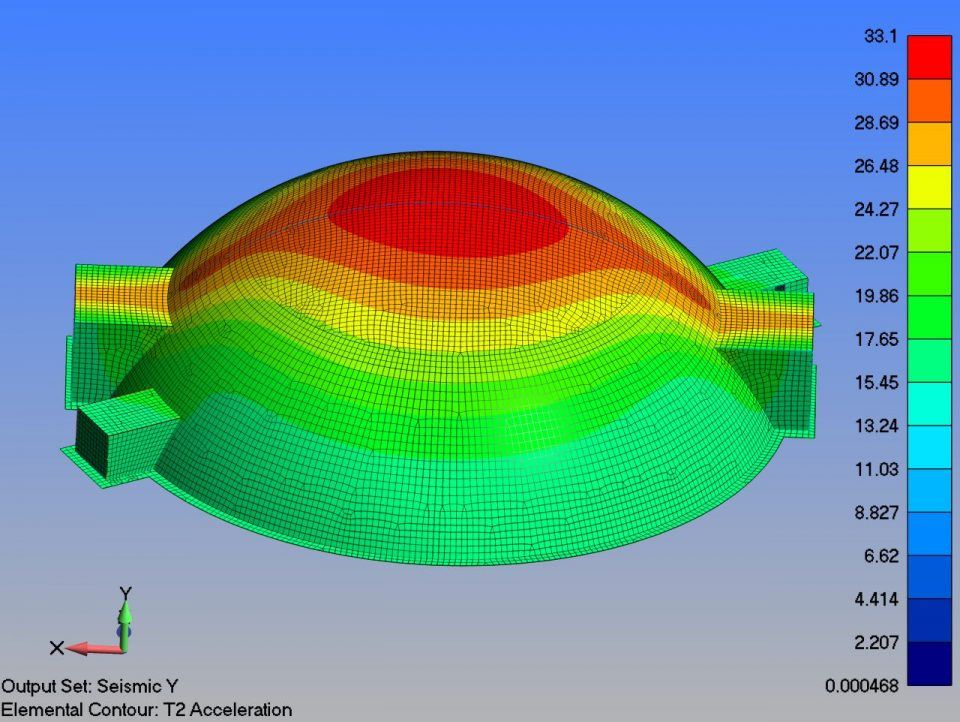Editor’s note: The following article was published in the July issue of Dry Cargo International.
By Zane Wells for Dome Technology
Building a durable dome for bulk storage requires a lot more than inflating a domed airform and placing concrete using the shotcrete method inside the dome. It also requires that the dome be designed for the stresses it will encounter over its lifetime.
To ensure a long-lasting structure, Dome Technology engineers utilize finite element analysis to determine how the dome will behave when loads are applied. These loads include self-weight, snow, wind and seismic, in addition to the pressure loads from the stored material. All of these loads impact the stresses in the dome in their own unique ways.
Imagine this: A dome is sized based on the required storage volume for the stored material, and an initial thickness is assumed based on previous experience. Engineers use a closed-form methodology based in classical engineering theory to identify the correct thickness and reinforcement for the structure. It’s the starting point of the design, if you will. The closed form solution identifies the stresses in the shell due to the applied loads.
The geometry is then drawn up, and the required thickness and amount of reinforcement is specified on the plans. Local building codes spell out stress and deflection criteria for a structure, or how a structure should be designed to resist applied loads. The building codes are written around typical frame and bearing-wall structures. These structures behave in a very well understood manner. Concrete shells, including domes and silos, do not resist loads in the same manner as frame and bearing-wall structures, so further analysis is done to ensure code compliance and safety of the system.

Finite element analysis determines how a dome will behave when loads are applied.
A computer model of the dome is created in FEA software. The software then breaks the model into smaller pieces — the finite elements. Loads are applied to the dome model, and the software analyzes the dome to determine the stresses and deflections due to the various loadings. These stresses are used to verify the specified reinforcement, and any areas of stress concentration are further investigated. The deflections of the system are used to identify the areas most likely to buckle under real-world loading situations. With those points identified, additional structure can be specified on the plans.
This tool is invaluable for customers because high-stress areas are identified and actions are taken to design the concrete structure to resist the loads on the dome shell. Here are three ways customers benefit from FEA:
Longer life for the structure
]By identifying which portions of the dome will bear the brunt of pressure and loads inside and out, the dome is reinforced where needed, meaning the structure will have strength where it needs it for decades to come.
For example, a customer might request a bigger opening to access the stored product; FEA will show what construction materials are required to make the dome strong enough to support the opening. FEA is also an important way to determine how a dome will behave when a headhouse or conveyor is supported on the dome apex.
Eliminated unnecessary spending
This works in reverse too. Sometimes an engineer might assume a certain point in the dome could be compromised with additional loads and suggest more reinforcement be added there. But FEA software eliminates the guess work (and manual math) by identifying if that’s actually the case. When that happens, unnecessary extra reinforcement is eliminated — and so is unnecessary spending.
Better preparation for weather events
Because FEA analyzes how the pressures of tornado, earthquake, hurricane and heavy snow loads will interact with the dome shell, the dome itself can be designed to better withstand natural disaster. In high wind areas, like Tornado Alley in the United States, or high seismic areas, like Chile in South America, this is especially beneficial.